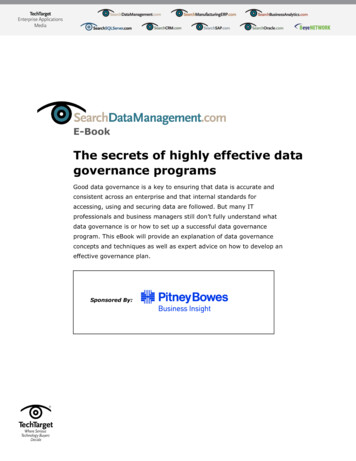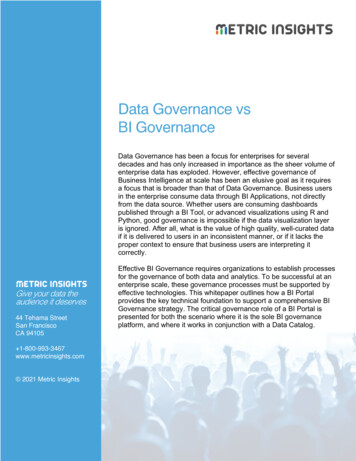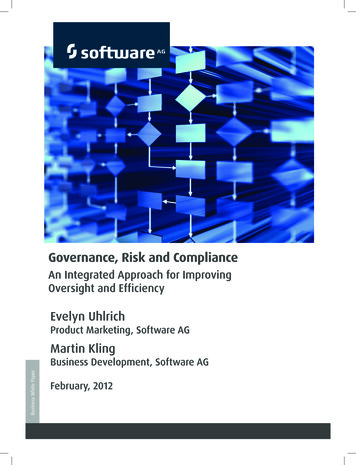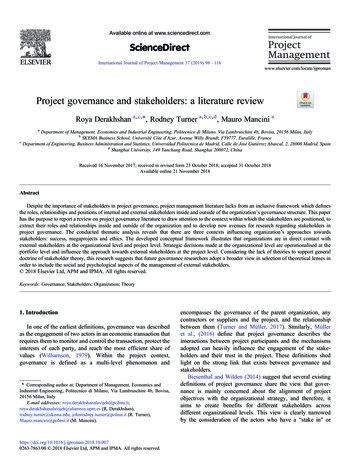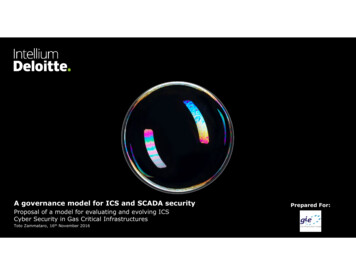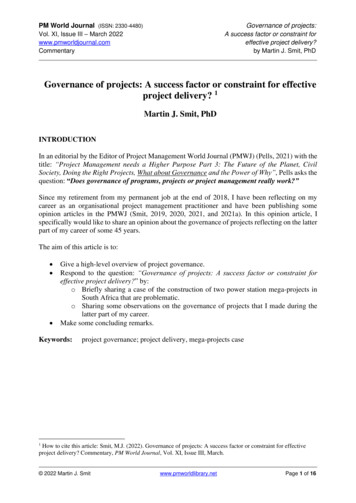
Transcription
Proceedings of the International Conference on Industrial Engineering and Operations ManagementMonterrey, Mexico, November 3-5, 2021The Impact of Project Governance on Project Delivery InThe Enterprise Project Management Office Within SouthAfrican BankKhathutshelo Mushavhanamadi, N.PhatlhaneDepartment of Quality and Operation ManagementUniversity of Johannesburg, South Africakmushavhanamadi@uj.ac.zaAbstractEffective project governance and project management are fundamental mechanisms of ensuring that projects aresuccessfully delivered within the project timelines. It involves a multifaceted set of relationships with stakeholders inan organization. Project governance provides a structure through which project related objectives are set, and themeans of accomplishing those are documented and prioritized. In summary, the purpose of this paper was to providea comprehensive understanding through documentation and re- search on the impact of project governance impact onproject delivery. The research also intends to increase awareness of the inherent risks associated with poorimplementation of project governance which leads to poor project delivery and consequently project failures. A mixedmethod research approach was under- taken where data was gathered through primary and secondary sources. Aquestionnaire was circulated in one of the branches in Johannesburg Enterprise Project Management Office, to apopulation of 58 staff in EPMO comprising of Head of Department, 6 senior project managers and 51 junior staffmembers. Half of the respondents know the tools and techniques used by EPMO and are readily in place to be used,but Half neither agreed nor disagreed. Almost all respondents indicated that the EPMO does not have to change thecurrent project management approach.KeywordsProject Management, Bank, Project Governance1. IntroductionProject governance has become an important role in organizations and every activity within an organization begins asa project, (Rankins, 2010) states that organizations are facing challenges in extracting maximum value frominvestments in projects. Project governance has been used to approach and meet the organizational objectives in eitheracademic or application (Joslin, and Müller, 2010). Research evidence by Khan (2019) also suggests that poor projectgovernance is widespread and is neither company nor industry specific (Joslin, and Müller, 2016). This includeshistorical information available as evidence to indicate to those in corporate governance the need for more effectiveproject governance from the outset in many projects. According to Murray, (2011) there is a difference betweenindividual governance of projects and project management governance. www.best-management-practice.commentioned that individual governance speaks about how a specific project is governed and project management isthe capability of the organization governed as a whole.Good governance needs leadership as it is critical for both the governance of both project and project management.South African bank has a functional department which manages the cross functional departments such as CashDelivery (deals with cash logistics for the bank), Self Service Delivery (Auto Teller Machines and Auto DepositMachines), Branch Delivery (Retail banking) and International bank (International branch outlets and offices). Tocarry out a project known as an Enterprise project management office (EPMO)Enterprise project management officeis set to deliver quality solutions to businesses within the constraints of project management which is time, quality,resources and cost.This paper gives an insight on how project governance is while being systematically in place within organizations andthe relationship it has with project deliverance in enterprise offices in order to give an emphasis of the proper use of IEOM Society International720
Proceedings of the International Conference on Industrial Engineering and Operations ManagementMonterrey, Mexico, November 3-5, 2021project governance in delivering successful projects in the enterprise offices. The formatter will need to create thesecomponents, incorporating the applicable criteria that follow.2. Literature ReviewA. Project GovernanceGovernance originates from the Greek verb “kubernan”, which is considered to steer and was derived from the Latinverb “gubernare” (Shefter, 1993). According to OECD, (2014) governance is collaboration of relationships betweenan organization management, its board, its shareholders, and other stakeholders. The concept of governance has alsobeen reviewed to pro-vide dominion in a project environment, as mentioned in Previous paragraph. Governanceprovides the structure through which the objectives of the company are set, and the means of attaining those objectivesand monitoring performance are determined (www.best-management-practice.com)According to (Rankins, 2010) project governance provides a management structure for the project and mandatespolicies, procedures, and management methods, and allocates stakeholder responsibilities and accountabilities.Despite the adoption of project management methodologies, some organizations still face tough challenges to achieveproject success. Some of the challenges faced by the project team could be attributed to the culture of its organization”(Murugesan, 2012)B. Project StructureAccording to a study conducted by Larson, and Gobeli, (1989) a type of structure used in a project influenced theoutcome and performance of the object to support the study (Li, 2019). It is the best organizational structure for theproject to be successful” although this research does not touch base on the type of structure used it can however beconcluded that there is a relationship between project success and the project structure utilized. “It was also revealedby Wu, Hu, Zheng, Zhao and Zuo, (2019) that unstable structures of project stakeholders negatively affect projectC. Key Performance IndicatorTo ensure that there is an alignment of corporation objectives and projects and stakeholders’ expectations, reliableand timely information must be readily available, based on performance indicators, as part of the project s controlsystem (do Rosário Bernardo, 2014). Sharma, Stone, and Ekinci, (2009) states that there are eight elements to guideproject design of which key performance indicators (KPIs) can be derived, and these are: purpose and relevance of aproject, time, complexity, intensity, connection and communication, access, sharing, and noveltyD. Project delivery of projectAccording to Murugesan, (2012), implementing the three project governance pillars as a foundation contributes toproject success which depends on having well defined realistic goals and impel- mentation plan. Sankaran,Remington, and Turner, (2008) explained that projects that perform poorly signal a credibility gap as to the need forand competence of management in project mode. Some stakeholders are not aware of what they are required to dobased on the project charter, and project governance framework, resulting in senior management not being directlyinvolved in projects or there are no clear roles and responsibilities or direction of the project. This is an indication ofhow poor or lack of project governance impact on successful project delivery (Sankaran, Remington, and Turner,2008).According to Sankaran, Remington, and Turner, (2008) any delay in project delivery times can cause poor delivery ofprojects, they emphasis- size that timely delivery of projects within budget and to the level of the quality standardspecified by the project initiator is an index of successful project delivery. According to Sharma, Stone, and Ekinci,(2009) Effective project governance is built on three critical factors: (1) leadership, organization, and decision rights,(2) importance of flexible and scalable processes improvement, and (3) the use of enabling technology. The processof project governance must start with setting clear objectives and proper planning to provide project direction.Senior Management Involvement and Project QualityProject success requires acceptance by the end-user or customer without disturbing the main workflow of theorganization or changing the culture thereof. However, there is a challenge with achieving project success as it haskey areas of uncertainty: time, cost, performance, quality estimates, project stakeholder performance uncertainty, andproject lifecycle or stages uncertainty. Sharma, Stone, and Ekinci, (2009) states that the absence of senior managersin projects has resulted in poor delivery of projects in some cases or caused project managers to work extremely hardin achieving the desired level of engagement by senior managers. IEOM Society International721
Proceedings of the International Conference on Industrial Engineering and Operations ManagementMonterrey, Mexico, November 3-5, 20213. MethodsThe researcher will explore and investigate the impact of project governance on successful project delivery inEnterprise Project Management Office within the Bank and make recommendations which will further improve projectdelivery in future. The researcher identified 58 respondents who will be used as part of data collection and this includessubject matter experts, but only 30 responded. The project that runs for a longer duration need senior managementinvolvement and will assist in getting stakeholder involvement and buy-in. The researcher chooses number ofemployees to secure data from EPMO and will also issue questionnaires.4. Data CollectionAccording to Sekaran, and Bougie, (2016) data can be obtained from primary or secondary sources.EPMO records can assist in determining the direct impact of poor project delivery to business units, but other indirectfactors may be less measurable but justifiable. Primary data sources include Transcripts of Interviews Feedback fromquestionnaires. Primary data will then be collected using closed ended questions and interviews. Secondary datasources include Journals bank monthly reports Textbooks.5. Results and DiscussionFindingsTo explore how poor project governance impacts the successful delivery of projects, a mixed methodological approachwas undertaken into consideration with physical distribution of questionnaires to the 58 staff of EPMO made up ofthe head of the department, senior project managers, junior project managers, project administrators and businessanalysts. The respondents ranged from junior positions to middle management who have all been formally trained forproject management and have projects they are managing or are involved in. A questionnaire was developed to assistthe researcher to answer the research questions and ultimately achieve the objectives. The questionnaire was dividedinto four sections which all addresses the four research questions stated in the introduction section and by answeringand analysing the questionnaire, it will be revealed if the research objectives have been met or not. The questionnairewas physically handed out with response received physically as well. The main points that emerged will be discussedbelow (figure 1):Figure 1: Survey result role in an organizationThe graphic illustration indicates the participants within EPMO and of the targeted roles, how many responded. Thisindicates where most of the responses will be coming from. The BAs, Pas and Lead Project Managers make up mostof the responses as they responds were 40 percent,20 percent and 20 percent respectively, while the other remaining20% was divided amongst the other roles. IEOM Society International722
Proceedings of the International Conference on Industrial Engineering and Operations ManagementMonterrey, Mexico, November 3-5, 2021What are the factors contributing to poor project governance?I follow the Group Project RiskManagement Framework as agovernance standard for my projects0% 0%Strongly Disagree17%DisagreeNeutral50%Agree33%Strongly AgreeFigure 2: Group Project Risk Management Framework as a governance structureThe above figure2. illustrates how participants value group project risk management as governance while deliveringproject ,50% of the respondents were indifferent about following the group project risk management as an integral forprojects, although 33% of the respondents agree to using group project risk management framework to govern the.The gap between those who agree and those who are neutral highlights an area that business needs to focus on toimprove their business operations.Roles and responsibilities are clearlydefined for projects17%6%Strongly Disagree17%Disagree10%NeutralAgreeStrongly Agree50%Figure 3: Are roles clear when delivering a projectThe above figure 3 clearly illustrates those roles and responsibilities are clearly defined since 17% of the respondentsindicated that roles and responsibilities are not outlined while delivering a project although 50% of respondentsindicated that there are clearly defined roles and responsibilities, and 10% remained neutral.Projects do not need frameworks10%Strongly Disagree13%0%Disagree50%NeutralAgree27%Strongly AgreeFigure 4: Are Frameworks needed when developing a project?The above figure 4 illustrates that the Overall the department is aware of the importance of following standards as setby the framework but in practice based on the previous section, seem to be having gaps 27% of the respondentsdisagreed while 50% agreed. Results and discussion. IEOM Society International723
Proceedings of the International Conference on Industrial Engineering and Operations ManagementMonterrey, Mexico, November 3-5, 2021Communication is critical to projectsuccess0%0%0%Strongly Disagree33%DisagreeNeutralAgree67%Strongly AgreeFigure 5: Importance of communication in project governanceThe above figure 5 shows the importance of communication while governing a project, 33% agreed and 67% stronglyagreed that communication is critical while delivering a project as they have to be in sync with one another.I have capacity to deliver projectrequirements0%7%10%Strongly DisagreeDisagree33%Neutral50%AgreeStrongly AgreeFigure 6: Capacity required to deliver a projectThe figure 6. above illustrates the necessity of having the capacity to deliver a project, 33% and 7% of the respondentsagreed and strongly disagreed respectively that they have the necessary capacity to deliver the required project, while10% responded to not having necessary capacity to deliver projects, and 50% remained neutralProcesses are documented for theproject3%10%Strongly Disagree33%Disagree27%27%NeutralAgreeStrongly AgreeFigure 7: standard process followed to document project.The above figure 7 shows the standard processes documented for projects, 27%and 33% agreed and strongly disagreedrespectively which shows that there is a standard process flow documented when delivering a project. while 13%disagreed to the statement, and 27% remained neutral, this however is an indication that trainings should be done forall employees to fully understand the process flow IEOM Society International724
Proceedings of the International Conference on Industrial Engineering and Operations ManagementMonterrey, Mexico, November 3-5, 2021Project governance improves qualitydelivery of the solution/end result13%Strongly DisagreeDisagree20%50%NeutralAgree17%0%Strongly AgreeFigure 8: The importance of project governance with delivering Quality project.The above figure 8 illustrates the importance of Governing a project in order to improve quality, 50 % of therespondents strongly agreed and see the importance of governing a project to deliver quality projects, while 33%disagreed and strongly disagreed this shows however that most the respondents clearly understands that Quality isessential in the department when running projects and ensuring the successful delivery of projects.Reports and documents must be ofgood quality0%0%0%17%Strongly DisagreeDisagreeNeutralAgreeStrongly Agree83%Figure 9: Standard Quality required when delivering a projectThe above figure 9 illustrates that respondents understands that following standard procedures is essential whendelivering a project as 83% and 17 % of respondents strongly agree and agree respectively .What tools and techniques can yourecommend to increase efficiency orquality of projects10%7%FrameworkPMBOK7%23%53%AgileRisk ManagementNo suggestionFigure 10: Recommended tools and techniques needed for improvementsThe above figure 10, illustrates the different tools and techniques recommended by the researcher to improve projectdelivery in an organization although 53% of the respondents didn’t comment, most of the respondents suggested thatPMBOK would be a great tool to deliver successful projects.A. Adherence to Project GovernanceMajority of respondents manage a maximum of 5. We can, therefore, say that projects are well shared within thedepartment without considering the size and complexity of projects. There is not much compliance with meetingdeadlines as a considerable number of respondents indicated that they do not know the governance process. There is IEOM Society International725
Proceedings of the International Conference on Industrial Engineering and Operations ManagementMonterrey, Mexico, November 3-5, 2021also a considerable level of non-compliance to the governance process as there is a small percentage of respondentswho do not know governance processes and do not know attributes of a successful project. Majority of the respondentsindicated. Some respondents indicated that they do not follow governance for their projects. These findings make theextent to which project governance assists EPMO is unclearB. Epmo Governance ApproachHalf of the respondents indicated that they follow group frameworks for project management and the majority ofrespondents indicated that they know their project stakeholders. A more significant number of responses indicate thatrespondents do not know the project charter and a significant few indicated disagreement with the use of a projectstandard. The majority indicated that they know what is expected of them.C. Factors Contributing to Poor Project GovernanceAll respondents indicated that communication is essential for project success. There is still a significant number ofemployees with no clearly defined roles in the projects and do not know their role in the initial stages of projects.Majority of the respondents agreed to be assigned to the project. Majority of the respondents did not indicate if theycan manage their projects or not. All respondents indicated that they received formal training to be in their roles. Allrespondents are aware of their KPIs. There is a significant number of respondents with no knowledge of documentedprocesses. A significant number of respondents indicate that project governance does not improve the quality ofprojects. All respondents believe project reports must be of good quality and for the project team to share a commonpurpose and collaborate. A significant number of respondents indicated that some stakeholders are not activelyinvolved in projects half of the respondents neither agreed nor disagreed to the involvement of senior managers inprojects.D. Tools And Techniques to Assist EpmoHalf of the respondents know the tools and techniques used by EPMO and are readily in place to be used, but Halfneither agreed nor disagreed. Almost all respondents indicated that the EPMO does not have to change the currentproject management approach. They indicated that EPMO could continue using Frameworks and risk management asa project governance approach, but they can add Agile and more PMBOK principles.6. ConclusionThis research shows that there is a project charter in place, there is communication in place, they have tools andtechniques in place, there is senior management involvement in projects, there are several successful projects, andthere are adequate stakeholder engagement and involvement. However, the research has indicated operational gapswithin the project management process in EPMO where there have been operational inconsistencies which do notmatch the project governance process.7. RecommendationThe main implication for EPMO management is that there needs to be a department-wide training and educationaware- ness on the EPMO project management value chain to give employees a view of how each role, each function,each project fits into the greater scope of EPMO. EPMO needs to create awareness of project administration andmanagement and the difference with the day-to-day role requirements, and there needs to be aware on how to prioritiesprojects to meet deadlines or focus on projects with high impact on business. Another implication for management isto decide how they will ensure that each staff member follows and adheres to project governance within the projectprogrammers they are managing. They need to educate staff that EPMO culture is aligning to bank’s culture of notputting results before ethical conduct. Management needs to decide on how they will roll out a general approach toproject governance in line with the Group Project Risk Management Framework and EPMO Strategy.There need to be effective escalation procedures in place for non-compliance because strong project management begins with a sound project plan which must include project governance management. Through the project charter, eachstakeholder must have their clearly defined roles and responsibilities so that stakeholder engagement. There needs tobe a steering committee that will oversee and monitor governance and give feedback every month. The departmentmust also be open and willing to adjust when changes to the project governance processes are made, or changes aremade to the framework or operational changes must be enforced.Tools and techniques to be used by EPMO will include the Group Project Risk Management Framework and theProject Management Framework. PMBOK has been incorporated in both these frameworks while Agile will have to IEOM Society International726
Proceedings of the International Conference on Industrial Engineering and Operations ManagementMonterrey, Mexico, November 3-5, 2021be decision management needs to make because Agile does not form part of governance standards set out in the GroupFrameworks for project management. Other tools and techniques exist and will have to be properly executed: projectscheduling, project reports, project milestones, responsibility matrix, communication plan, and resourcing plan, riskreport, project log and change request documents.ReferencesDo Rosário Bernardo, M., 2014. Performance indicators for enhancing governance of projects. Procedia-Social andBehavioral Sciences, 119, pp.55-64.Joslin, R. and Müller, R., 2016. The relationship between project governance and project success. International journalof project management, 34(4), pp.613-626.Larson, E.W. and Gobeli, D.H., 1989. Significance of project management structure on development success. IEEEtransactions on engineering management, 36(2), pp.119-125.Li, Y., 2019. Which organizational structure will facilitate the success of your project. PM World Journal, III, pp.119.Murugesan, R., 2012. Leadership Dimensions for Engineering Project Success. IUP Journal of OrganizationalBehavior, 11(4).Murray, A., 2011. Prince2 and Governance. White Paper, Best Management Practice, The Stationery Office,London.m. A, "best-management practice," 30 May 2009. [Online]. Available: www.best-management-practice.com.[Accessed 30 September 2009]." OECD principles of corporate governance, Organisation for Economic Co-operation and Development (OECD,"Organisation for Economic Co-operation and Development (OECD, 2004.Rankins, G.J., 2010. Column: Trends. Project Manager, The, 30(1), p.22.Sankaran, S., Remington, K. and Turner, C.R., 2008. Relationship between project governance and Projectperformance: A multiple case study of shutdown maintenance projects in a maritime environment. In PMIGlobal Congress Asia Pacific Project Management Conference. Project Management Institute.Sankaran, S., Remington, K. and Turner, C.R., 2008. Relationship between project governance and Projectperformance: A multiple case study of shutdown maintenance projects in a maritime environment. In PMIGlobal Congress Asia Pacific Project Management Conference. Project Management Institute.Shefter, M., 1993. Political parties and the state. Princeton University Press.Wu, G., Hu, Z., Zheng, J., Zhao, X. and Zuo, J., 2019. Effects of structure characteristics of project network onconflicts and project success. Engineering, Construction and Architectural Management. IEOM Society International727
Effective project governance and project management are fundamental mechanisms of ensuring that projects are successfully delivered within the project timelines. It involves a multifaceted set of relationships with stakeholders in an organization. Project governance provides a structure through which project related objectives are set, and the




